If you are planning to start an online store, you have likely encountered two major platforms: Shopify and WooCommerce.
After helping countless online store owners through WPBeginner, we’ve gained deep insights into what makes each one unique. The truth is, both Shopify and WooCommerce can be excellent choices – but for different reasons.
Your choice should depend on factors like your technical comfort level, budget, customization needs, and long-term business goals.
Today, we will break down the key differences between Shopify and WooCommerce, comparing everything from costs and features to flexibility and ease of use.
By the end, you will have a clear understanding of which platform better suits your needs.
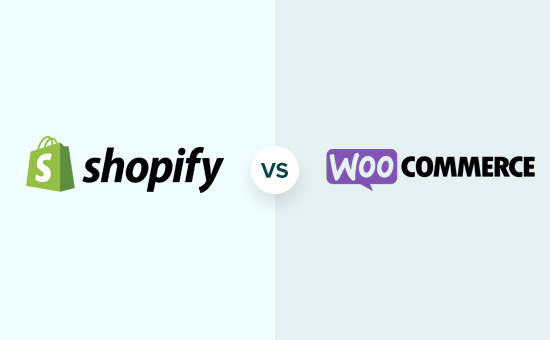
Since this is a detailed comparison of Shopify vs. WooCommerce, here’s a quick table of contents. You can use the quick links below to jump the section you want to read:
- Overview: Shopify vs. WooCommerce
- What to Look for in Your eCommerce Platform
- Cost: Shopify vs. WooCommerce
- Ease of Use: Shopify vs. WooCommerce
- Payment Methods: Shopify vs. WooCommerce
- Integrations and Add-ons: Shopify vs. WooCommerce
- Shopify vs. WooCommerce Dropshipping
- Scalability and Growth: Shopify vs. WooCommerce
- Support Options for WooCommerce vs. Shopify
- WooCommerce vs. Shopify: Which is the Best eCommerce Platform?
- FAQs about Shopify vs. WooCommerce
Overview: Shopify vs. WooCommerce
Before we start with our in-depth comparison of the two most popular eCommerce platforms on the web, it’s important that we cover the basics and highlight what makes these platforms stand out.
What is Shopify?
Shopify is an all-in-one eCommerce solution that makes it easy for you to create an online store, accept payments, and manage your inventory, all from a single platform.
With Shopify, you don’t need to worry about the technical aspects of managing an eCommerce site, such as web hosting, security, caching, etc.
What is WooCommerce?
WooCommerce is an open-source eCommerce plugin built for WordPress. It allows you to leverage the most powerful content management system (CMS) and use it to run an online store.
WordPress is the most popular website builder on the planet, powering 43% of all websites. What many don’t know is that WooCommerce is the most popular eCommerce platform (yes, even more popular than Shopify), with 6.6 million users.
Because of the open-source nature of WooCommerce, you can customize every aspect of your store and easily add custom extensions.
The decision to choose between the two platforms depends entirely on your needs and skill level.
What to Look for in Your eCommerce Platform
There are a few things that you absolutely need to keep in mind when starting an online store. These key factors will help you decide which platform is better suited for your needs:
- Budget – The initial cost of starting a fully functional eCommerce store.
- Ease of use – It should be easy to use even for absolute beginners.
- Payment Methods – It should have support for multiple payment methods (e.g., PayPal, Stripe, and other merchant processors).
- Integrations – The number of services and third-party tools you can integrate to grow your eCommerce business.
- Scalability – The platform should be able to scale as your business grows.
These are the very basic requirements that all online store owners must consider. However, depending on your needs, you may also want to look at other options like shipping, inventory management, invoicing, taxes, dropshipping, etc.
Our goal with this article is to take an in-depth look at how Shopify and WooCommerce stand on these basic requirements and which one of them is best suited for your needs.
That being said, let’s start our Shopify vs. WooCommerce comparison.
Cost: Shopify vs. WooCommerce
Cost is often the most important consideration for eCommerce website owners. You need to evaluate the cost of getting started while also keeping in mind the variable costs for add-on services and software.
The True Cost of Using Shopify
Shopify makes it super easy to start your online store. Their Basic plan starts at $19 per month (billed annually), and you can upgrade to the Shopify plan for $49 or the Advanced Shopify plan for $299 per month.
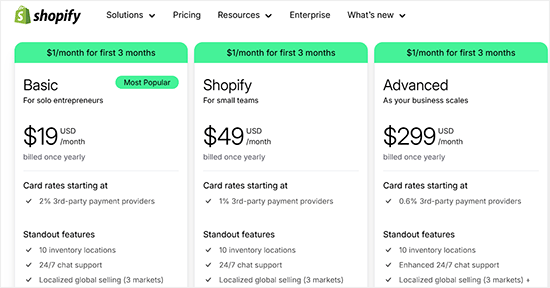
Each of these plans includes an SSL certificate and web hosting. It will come with a Shopify branded subdomain (e.g. https://your-store.myshopify.com).
If you want to use your own .com domain name, then you’ll need to purchase it separately. Pricing for a regular .com domain name generally starts at $14/year.
The basic Shopify plan comes with enough features to set up a new online store. You can add unlimited products, 2 user accounts, unlimited file storage, and more.
However, this pricing doesn’t include third-party tools and add-ons that you’ll need to take your Shopify store to the next level. As your business grows, these costs will start adding up, and you’ll soon be paying a lot more than the basic plan.
Payments are another factor that affects your costs. Shopify offers its own Shopify Payments solution, which costs 2.9% + 30 cents per transaction for the basic plan.
If you want to use third-party payment gateways or your own merchant account, then you will be charged a flat fee of 2.0% for all transactions. You can reduce this fee to 0.5% by using the Shopify Advanced plan, which costs $399 per month.
These payment processing fees are fairly steep when using external payment gateways. However, if you’re just starting out and want to use the Shopify Payments solution, then the fees are fairly comparable to popular platforms like Stripe and Braintree.
Shopify also offers a plan called the Shopify Starter Plan, which costs $7.00 / month. This plan lets you add buy buttons to any site or use Shopify for in-person sales in select regions.
For instance, you can create a WordPress website and add Shopify buy buttons there. However, if you are already making a WordPress website, then using WooCommerce would allow you to offer a much better experience.
The True Cost of Using WooCommerce
WooCommerce is an eCommerce plugin for WordPress.org (also known as self-hosted WordPress). It is open-source and available as a free plugin.
However, you’ll need a domain name, SSL certificate, and a WordPress hosting account to start a WooCommerce store.
Typically, a domain name costs $14.99, an SSL Certificate costs $69.99, and web hosting costs around $7.99 / month. This is not cheap, particularly when you are just starting.
Thankfully, there are several hosting companies that are now offering specialized WooCommerce hosting plans, which significantly reduce the cost.

Bluehost, an official WordPress and WooCommerce-recommended hosting provider, has agreed to offer our users a free domain name, a free SSL certificate, and a discount on web hosting.
This will help you start your online store for as low as $1.99 / month.
As you can see, the cost of starting a basic WooCommerce store is significantly lower than Shopify. WooCommerce also doesn’t charge you a percentage fee on transactions, which is a very nice perk.
Keep in mind that WooCommerce costs start adding up as you purchase paid extensions. Your hosting costs will also increase as your online store grows.
However, one clear advantage of using WooCommerce is that you can often find free alternatives to premium themes and paid extensions. You can also keep your costs in control by only purchasing the tools and plugins as you need them.
With the number of free themes and free add-ons available for WooCommerce, it’s the winner in terms of cost.
Winner: WooCommerce
Ease of Use: Shopify vs. WooCommerce
Most users starting an online store are not web designers or developers. Even users who are familiar with basic concepts need a platform that is easy to use and gets out of their way.
Let’s see how Shopify and WooCommerce stack up in terms of user-friendliness.
Shopify – Ease of Use
Shopify is a fully hosted platform, which means you don’t need to install, manage, or update any software. You also don’t need to worry about security, performance, backups, and compatibility issues.
As soon as you sign up, you can choose a design from many of the free Shopify themes. After that, they walk you through customization and then help you add products.

Shopify comes with an intuitive drag-and-drop interface. Managing your product pages, sales, and inventory inside Shopify is a breeze.
One downside of this guided, polished, and highly optimized user experience is that it limits your control. You can only use the design and development tools provided by Shopify or add-ons available in their marketplace.
However, this is not as bad as it sounds. For most users, the large selection of extensions and themes available in Shopify is more than enough to get started and grow your online store.
WooCommerce – Ease of Use
WooCommerce is not a hosted platform like Shopify. This means you will need to install the WooCommerce plugin, manage updates, keep backups, and make sure that your website is secure.
There are plenty of free and paid plugins that can automate most of these tasks for you.
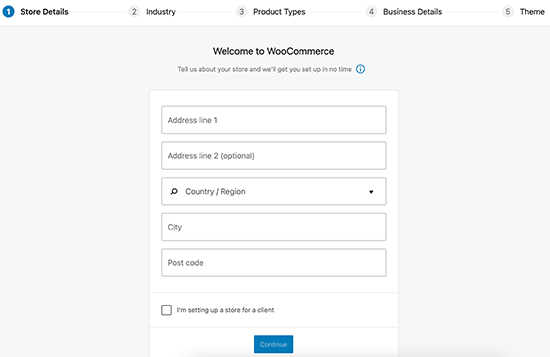
WooCommerce is super flexible when it comes to customizations. You have full control of the whole platform. You can add any functionality imaginable to your website with the help of more than 59,000+ WordPress plugins.
However, there is no built-in drag-and-drop design builder. You can use one of the WordPress page builders like SeedProd.
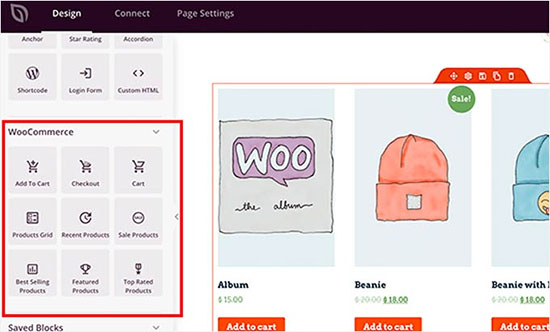
The biggest downside of the flexibility is that it comes with a learning curve and requires more hands-on management of your website. You also have to sign up for a merchant account or similar service like Stripe / PayPal.
While the WooCommerce guided setup wizard is helpful, it does not come close to the onboarding experience and ease of use of Shopify.
Winner: Shopify
Payment Methods: Shopify vs. WooCommerce
There are many payment gateways that you can use to accept payments online. Some payment methods may not be suitable for you, and others may not be available to your customers.
This is why it’s important that the platform you choose offers multiple payment options. Let’s take a look at how Shopify and WooCommerce compare when it comes to payment integrations.
Payment Options in Shopify
Shopify offers plenty of payment options that customers can use during checkout. It has its own payment solution called Shopify Payments (powered by Stripe), as well as all popular third-party payment gateways.

The problem is that Shopify charges an extra 2% fee on each transaction made through third-party payment gateways. This is on top of the transaction fees charged by the payment gateway. You can reduce the fee to 0.5% by paying $399 per month for the Advanced Shopify plan.
Shopify Payments has credit card fees but no other transaction fees. Credit card rates start from 2.9% + 30¢ for the basic plan and get lower for other plans.
Payment Options in WooCommerce
WooCommerce offers PayPal and Stripe payments by default. They also have a WooCommerce Payments solution powered by Stripe.
It supports all other popular payment service providers as well. You can install payment integrations for Authorize.net, Amazon Pay, Square, Alipay, and many more.

For payment gateways, WooCommerce even has support for many regional and less popular payment services. Since there is no barrier to entry, any payment company can create add-ons for WooCommerce and provide support for it.
For example, you can use the free Stripe Payment Gateway for WooCommerce plugin by FunnelKit instead of the default WooCommerce option. It comes with extra features like an easy onboarding wizard, Google and Apple Pay express checkouts, and more.
As a self-hosted platform, you are only charged transaction fees by your payment gateway or your bank. Unless you are using WooCommerce Payments, WooCommerce never charges you a % fee on credit card payments, which is a major plus.
If choosing your own merchant account and using a third-party gateway is important for you, then you will save A LOT of money by using WooCommerce.
If you’re a small store and willing to use Shopify Payments, which has the same credit card rates as Stripe / Paypal, then it makes no difference.
Winner: Tie
Integrations and Add-ons: Shopify vs. WooCommerce
No matter how robust an eCommerce platform is, you’ll always need third-party tools and services to grow your store.
For example, you might need email marketing software, lead generation tools, analytics tools, outreach services, and more.
Both Shopify and WooCommerce have an extensions directory, and they integrate with many third-party services.
Shopify Add-ons and Integrations
Shopify comes with a powerful API and an App Store where you can buy third-party add-ons for your Shopify store. They have hundreds of apps in the store covering every feature you’ll want to add to your store.
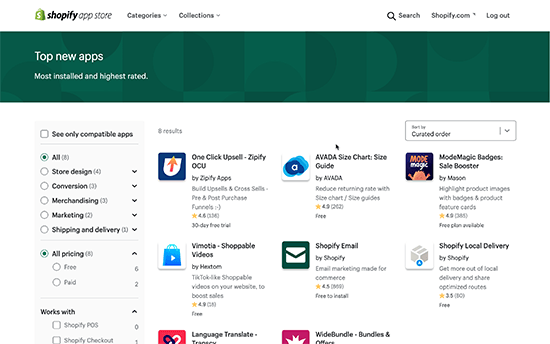
For lead generation, they have integrations with software like OptinMonster, which helps you grow your email list and reduce cart abandonment. There are also Shopify apps for search engine optimization, product reviews, discounts, countdowns, and more.
Shopify’s app store contains both free and paid apps. Free apps are usually created by third-party services that have their own pricing, and the app only integrates your store to their APIs. Pricing for paid add-ons varies, and most apps offer monthly subscriptions.
In terms of numbers, there are fewer add-ons and extensions for Shopify than for WooCommerce / WordPress. That’s because it can be difficult to get an app listed in their store.
Having personally gone through the process of submitting a plugin for WordPress and submitting an app to the Shopify store, we can say that the process is harder on Shopify vs. WooCommerce.
WooCommerce Add-ons and Integrations
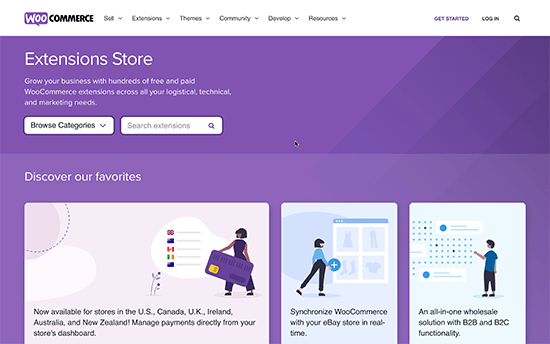
WooCommerce is open source and built on top of WordPress. This gives you access to more than 59,000+ free WordPress plugins and many more paid plugins.
You can use these add-ons to add payment gateways, lead generation, eCommerce SEO, performance optimization, social media integration, and almost any feature you can think of.
Due to the lower entry barrier, there are many more integrations and add-ons available for WooCommerce than for Shopify. Almost all third-party tools and service providers have their own plugins to seamlessly integrate with your WooCommerce store.
Here are some of the best WooCommerce plugins that we recommend:
- OptinMonster – Easily create WooCommerce popups to reduce cart abandonment, increase sales conversions, get more email subscribers, and more.
- All in One SEO – A complete SEO toolkit that will help you quickly optimize your online store for better search engine rankings and higher traffic.
- MonsterInsights – The best Google Analytics plugin to easily track eCommerce data right from the WordPress / WooCommerce dashboard.
- SeedProd – The top drag-and-drop page and theme builder for WordPress. It integrates with WooCommerce to create custom checkout pages, carts, product grids, and more.
- FunnelKit – A powerful WooCommerce funnel builder that lets you create high-converting checkouts, Shopify-style sliding side carts, one-click upsells, order bumps, and more.
- FunnelKit Automations – Easily create automated email marketing and SMS campaigns for abandoned cart reminders, subscription reminders, and more right from WordPress.
- Advanced Coupons – The best coupon plugin to extend the WooCommerce coupon functionality and create better coupon offers to boost sales.
- Wholesale Suite – Easily set and display wholesale pricing in WooCommerce for bulk buyers and other businesses.
Having personally gone through the process of submitting a plugin for WordPress and submitting an app to the Shopify store, we can say that the process is much harder on Shopify vs. WooCommerce.
You can also hire a WordPress developer to create an integration or plugin just for your own website.
Overall, it’s important to keep in mind that WooCommerce is a lot easier to customize than Shopify.
Winner: WooCommerce
Shopify vs. WooCommerce Dropshipping

Dropshipping is an online business where an eCommerce store doesn’t keep the products in stock. Instead, it fulfills orders by purchasing products from vendors and then shipping them directly to the customers.
Due to its low overhead, dropshipping has become popular around the world. Many of our users asked us to compare WooCommerce vs. Shopify for a dropshipping business.
Dropshipping with Shopify
When building a dropshipping business, the front end of your website will look just like any online store.
Your users will be able to browse products, add them to their cart, and make payments, just like they would do on any other eCommerce store.

Depending on the vendors you choose, you will then have to place a user’s order for shipping.
Shopify also has integration apps for several popular dropshipping marketplaces like AliExpress, Oberlo, Printify, and more.
However, each of these product marketplaces has its own membership fees, shipping, and other charges that you need to keep in mind when building your dropshipping website with Shopify.
Dropshipping with WooCommerce
WooCommerce is a popular choice among dropshipping businesses. Mainly because of the flexible dropshipping plugins for WooCommerce that make the whole process quite easy to set up.
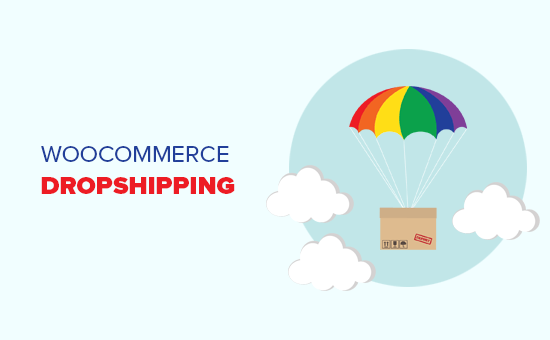
You can easily find extensions that allow you to instantly import products, fulfill orders from your website, and more. You can even create an eBay-like eCommerce marketplace, allowing other vendors to sell on your website.
Keep in mind that your supplier and vendor may have minimum order requirements, membership fees, and other charges. You need to keep those in mind when adding products to your WooCommerce dropshipping store.
Winner: WooCommerce
Scalability and Growth: Shopify vs. WooCommerce
You have probably heard the term “growing pains” from various CEOs and founders. As your business grows, you will need more resources to handle new challenges and goals.
Shopify and WooCommerce can both be scaled to handle a large amount of traffic and orders, but they’re not created equal. Let’s take a look at how these two eCommerce platforms compare when it comes to scalability.
Scalability on Shopify

Shopify handles the technical parts of your store, which means you don’t ever have to worry about performance, security, and scalability. Once your business starts growing, you can simply upgrade your Shopify plan.
Their infrastructure can easily handle your growing business without you having to worry about downtimes, backups, updates, or security. They also offer enterprise services as part of the Shopify Plus plan.

This takes out the painful part of the growth, but it also adds to your cost of business. Your expenses will grow, and you’ll have to plan accordingly.
The good part is that your costs will be offset by you not having to hire or manage a technical team in-house.
Scalability on WooCommerce

WooCommerce is a self-hosted platform, which makes you responsible for maintaining updates, backups, and security of your website.
Your starter WooCommerce hosting plan will run out of resources as your store starts getting more traffic.
The good news is that you have plenty of options to manage growth since you are in full control of your WordPress site.
Your WooCommerce hosting costs will increase, but you will have better control over the specific resources you upgrade, and you can make sure that you are not paying for resources that you don’t need.
You can even use a managed WordPress hosting provider like SiteGround or WP Engine to help scale your WooCommerce store.
Despite the control that WooCommerce offers, some small businesses simply prefer a hassle-free solution.
Winner: Shopify
Support Options for WooCommerce vs. Shopify
Both WooCommerce and Shopify are quite easy to use. However, sometimes you may need help to learn how to do something new in your store.
Let’s see how WooCommerce and Shopify handle support and the options they offer to get help when needed.
Support Options on Shopify
Shopify is a fully hosted platform, which means they control the software, and they are the ones who know their platform the best.
Shopify provides 24/7 customer support via live chat, phone, email, and Twitter. For users who want to fix things on their own, Shopify offers extensive documentation, how-to guides, a knowledge base, video tutorials, and forums.
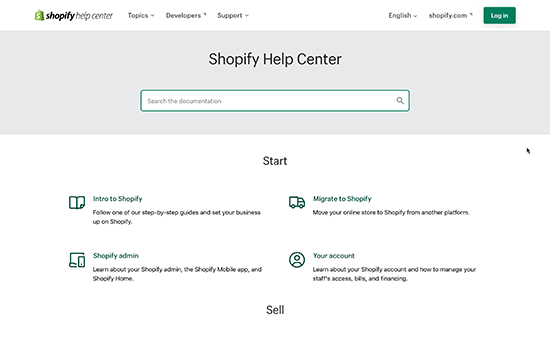
It also maintains a directory of Shopify Experts that you can hire if you need extra help or if you want to integrate a third-party solution.
However, Shopify doesn’t provide support for any third-party apps or templates that you are using.
Support Options for WooCommerce
WooCommerce is the world’s most popular eCommerce platform, which means there are tons of support options that you can use when needed.
The official website has extensive documentation, tutorials, and guides that allow you to help yourself. They also have support forums where you can get help from the WooCommerce support team and other users and experts.
They have recently added 24/7 chat support for anyone who purchases any premium extension or theme from WooCommerce.com.
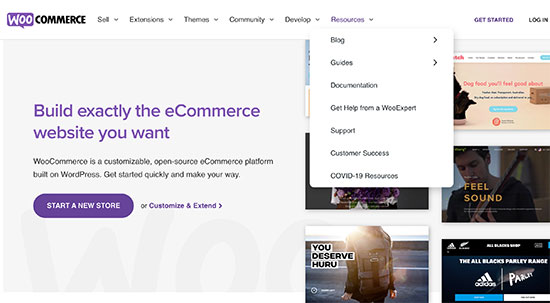
However, since WooCommerce is a self-hosted platform, your hosting provider is responsible for providing support for issues with your server.
For third-party WordPress themes and extensions, those developers are responsible for answering support questions regarding their products.
Due to its immense popularity, it is quite easier and often cheaper to find developers to help you fix issues with your WooCommerce store. You can find developers on freelancing websites to fix WooCommerce issues.
We also offer WordPress Support Services, where you can hire our professional team of WordPress engineers for quick troubleshooting and fixes.
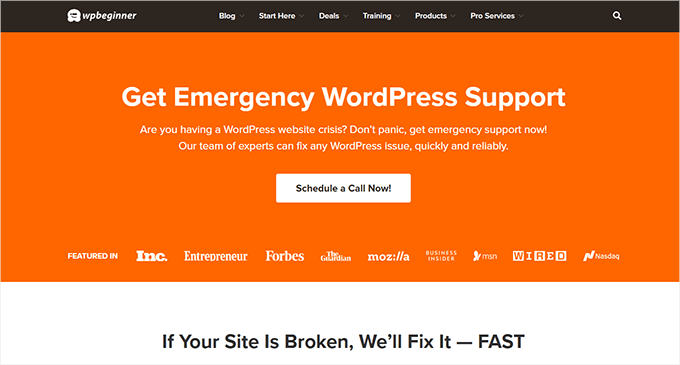
Winner: Shopify
WooCommerce vs. Shopify: Which is the Best eCommerce Platform?
Shopify and WooCommerce are both powerful platforms to start your eCommerce store. It truly comes down to your personal skills and preferences.
Shopify is a lot easier to use. It doesn’t require you to install anything, and you can get started quickly. Setting up payments is easier, and they have easy-to-understand pricing plans.
The disadvantage of Shopify is that you don’t have full control over everything. Your costs can go high with transaction fees, add-ons, and integrations. Your upgrade options are limited to select plans, and you cannot manage costs on a pay-as-you-grow basis.
WooCommerce is open-source and gives you full control of your website. It costs a lot less to start an online store with WooCommerce, especially with these WooCommerce hosting companies.
The disadvantage is that you’ll have to maintain the software. It comes with a bit of a learning curve. However, millions of beginners are already using it, and they get over the learning phase quite quickly.
If you are looking for a cost-effective solution and you want to have full control of your online store, then WooCommerce is the best platform for you.
If you want something that’s completely hassle-free and has infinite scalability, then Shopify is the better platform for you.
FAQs about Shopify vs. WooCommerce
Following are the answers to some of the most frequently asked questions about Shopify vs. WooCommerce that users have asked us.
1. How is WooCommerce different than Shopify?
Shopify provides their platform as a service. They provide the software and website hosting for your online store and take care of backups, security, and maintenance.
On the other hand, WooCommerce is a self-hosted eCommerce platform. You’ll need a WooCommerce hosting account and a domain name, and you’ll manage your online store by yourself.
Both platforms allow you to easily sell products online, receive payments via PCI-compliant third-party payment gateways, and manage inventory.
2. Which one is more popular, Shopify or WooCommerce?
WooCommerce is the world’s most popular eCommerce platform. According to BuiltWith, WooCommerce is used on 28% of the top 1 million websites, followed by Shopify at 20%.
WooCommerce runs on top of WordPress, which itself is the most popular website builder, powering more than 43% of all websites on the internet.
3. Can I use Shopify with WordPress?
You can use the Shopify Starter Plan with WordPress by installing Shopify’s Buy Now button. This implementation will take users to the Shopify cart to complete the checkout.
However, its implementation is a bit tricky and may not offer the best user experience. If you are using WordPress, then there are plugins like WPForms that allow you to accept payments online without installing a shopping cart plugin like WooCommerce.
4. What are some alternatives to Shopify and WooCommerce?
Shopify and WooCommerce are two of the top eCommerce platforms on the market.
eCommerce services that offer platforms as services like Shopify include BigCommerce, Squarespace, Wix, and more. WordPress plugins that you can use as WooCommerce alternatives include MemberPress, WPForms, Easy Digital Downloads, and more.
5. Which eCommerce platform is more flexible?
WooCommerce offers more flexibility due to its larger extensions library. It runs on top of WordPress, so it can be used for blogging and a business website at the same time.
It works with all email platforms like Constant Contact, Mailchimp, and more. You can easily optimize your website using an SEO plugin like All in One SEO or Yoast SEO.
You also get more WooCommerce themes from the free WordPress.org theme store. More importantly, you can easily use tools to boost conversions and abandoned cart recovery.
We hope this article helped you compare the pros and cons of Shopify vs. WooCommerce. You may also want to see our guide on how to set up eCommerce tracking in WordPress and our expert picks for the best WordPress eCommerce plugins.
If you liked this article, then please subscribe to our YouTube Channel for WordPress video tutorials. You can also find us on Twitter and Facebook.





Jiří Vaněk
I tried Shopify, but it has several disadvantages compared to WooCommerce. The first is data ownership. You can’t decide to take your store and migrate it to another provider after some time; it’s simply not technically possible. The second disadvantage, which is more relevant to my location, is the much smaller flexibility compared to WooCommerce. For example, when it comes to shipping goods. In the Czech Republic, there are many local carriers that people use, but Shopify doesn’t recognize them. Integrating them is problematic. For WooCommerce, there are plugins that allow me to not only include these carriers in my store but also provide tracking for the shipped goods. Lastly, Shopify’s pricing is a disadvantage. It’s really expensive compared to WooCommerce. Yes, I don’t have to worry about updates, speed, or optimizing the website, but the disadvantages outweigh the advantages for me compared to using the WooCommerce platform with WordPress.
Dennis Muthomi
For me, I still prefer using WooCommerce for my eCommerce store.
I have used both platforms before, but as a soloprenuer , factors like cost, flexibility, and control over my website are most important to me.
Mrteesurez
I term of payment gateway, woocomerce is the winner. It’s have support for multiple payment methods like PayPal, Stripe and some region payment gateway.
Not everybody is using stripe or familiar with it.
Woocomerce support some payment gateways from African, like paystack and others.
Also, integrations – we have more number of services and third-party tools that can be integrated to grow eCommerce with woocomerce.
WPBeginner Support
Thank you for sharing your opinion
Admin
Moinuddin Waheed
Shopify and woocommerce both are great platform to start an online business and both has its pros and cons.
But for any one with a tight budget just starting out and want to explore online business, I think woocommerce is cost affordable and gives a sense of control over the business and website.
Though it has a learning curve but is good for the long term business.
But if cost is not a problem, Shopify is the go to option as it requires you to just place your items and start selling, technical part being taken care by Shopify itself.
Thanks for the comparison, my understanding of both the platforms has increased.
Lara Carter
Its also really interesting and useful to see the comments with there experiences and opinions.
Lara Carter
This is really interesting, I’ve seen so many adverts for shopify and this made me realise all the other options and which is actually better.
WPBeginner Support
Glad we could share our information on WooCommerce
Admin
Ashwini
great post. it will help to learn the differnces btn woo and shopify.
Thanks for sharing
WPBeginner Support
Glad our guide was helpful
Admin
Shawn
Shopify is not good for SEO. Compared to using Wordpress plus Genesis framework along with pro Yoast SEO plugin. Night and Day!
WPBeginner Support
Thank you for sharing your opinion
Admin
Lokesh Indoura
Sir,
– I am regular reader of wpbegginer.
I want to ask that I have a wordpress blog. Which is monetized by google adsesne. Can I sell in this Blog my own product such as book. If it can. Please suggest me way. I will be grateful.
WPBeginner Support
Yes, you can use Google Adsense on an ecommerce site, for how to set up a store you would want to take a look at our article here: https://www.wpbeginner.com/wp-tutorials/how-to-start-an-online-store/
Admin
Dori
I currently have a wordpress blog and a Shopify Basic website. Being in Washington State with a complicated sales tax schedule, one thing I really like is the fact that Shopify correctly calculates our sales tax. No extra plugin needed. In a state requiring destination based sales tax collection, if you use WooCommerce you would likely need to install a plugin like TaxJar and pay $17/month. I am going to combine blog & webshop this year and will downgrade to Shopify Lite and paste code for my products into my blog. I’ll still be able to use Shopify’s inventory tracking, shopping cart, and shipping calculators…for $9.00/mo. plus transaction fees. If you are a small business with a limited number of products, it’s worth taking a look at. : )
WPBeginner Support
Thanks for your input, that is another factor that could be important for those comparing the two.
Admin
Bobby
You can install jetpack plugin with woocommerce tax (both are free) and enable automated sales tax. This way you do not need to enter each state each town/city or county.
Chris
The biggest problem with shopify, besides the outrageous cost of apps, is their default shipping box. This has been a known issue for years and they won’t address it because they get fees from shipping apps. If you sale more than 1 item that uses different shipping boxes, too bad, you can only set up 1 size. If you sale something that goes into a regular envelope and set it as default, shipping is low, but if you also sale something that requires a box, the customer will pay shipping on the envelope (because it’s your default package) and you pay the extra shipping costs. There’s no way to set up shipping packages for categories or per item. You get 1 and that’s it, eat the shipping costs.
WPBeginner Support
Thanks for sharing your experience and what to consider between these two
Admin
thomas stromschlag
Thanks for this compare
I just setup wooCommerce, but its always good to know what else could be. And yes, in woo is not everything pink
WPBeginner Support
Glad we could help inform
Admin
Jorge
Great comparison. Thanks! Do you know if you can have one or more email accounts when you host your store with Shopify?
Sanjal
Please mention that shopify takes some % from your orders as a transaction fee..Which as a web developer is okay but as a business its a great loss. Please mind that 2% is quite good amount which shopify takes…
LaWanda Hodges
Thanks VERY much for this article. I woke up this morning thinking, “Which platform will I use, Shopify or WooCommerce?”
Thankfully, your article was one of the first that popped up! Saved me time! LOL
Why did I find this article so helpful? Organized and to the point.
Good day!
Dominik Agejev
What do you mean by “Your hosting costs will also increase as your online store grows. “? Can you elaborate? Does this apply to Shopify as well?
WPBeginner Support
Hi Dominik,
As more visitors visit your website, your website will need more computing resources. To get those resources you will need to upgrade your hosting plan which will increase your cost.
Shopify is a fully-hosted plan. However, your costs will increase with payments, transaction charges, and addons.
Admin
Manoj Agarwal
This is a great article. I use both Wordpress and shopify a lot and have set up E-Commerce on both my own site and a client’s site. I think in general, people have heard of shopify , you’re a web developer or Wordpress user. I don’t pull in a lot of $$ on my site so shopify would be way too expensive. But if I had a lot of sales and didn’t have time to mess with WP, I would certainly try shopify.
Tikyda
Thanks a lot for comparing these two platforms.
Suzie C
I was almost going to try to spend the time doing WooCommerce and also figure out how to transfer my WordPress.com blog to WordPress.org in order to be able to do that. However, I see that Shopify has a ‘Shopify Lite’ option for $9/month by selling thru FB/social media. I’m only going to be selling a few things, so I think that option will be best for me. Good to hear that someone has a good experience with Shopify. I just want something easy!
Inbar
which platform is easier for the end user costumer?
Dominik Agejev
Shopify, but it’s more expensive for you.
Jason Banks
I’ve personally been using Shopify for almost 2 years now and I love it, BUT I’m a super small company. I pay $9.99 a month got access to their “Buy Button”. Essentially you add your product and you have the option to create a block of automatically creates a block of code based on 3 layouts and you copy the code and paste it wherever you want! I think it’s pretty genius. I actually have a WordPress website, that I control the updates and everything to, but I’m using the Shopify Buy Button on my custom WordPress Theme.
I’m currently having to really look into WooCommerce for my day job. My boss wants to know what we should go with for our Ecommerce platform and I just don’t want to say Shopify simply because I use it for my personal Ecommerce business.
Basically I’m having to do research with Shopify between a few thousand dollars a year business and a multi-million dollar a year business.
Crystal E
That is so identical to my situation, it’s almost scary! Did you ever find a solid solution to this? I would like to know any advice you have since I’m in the same boat.
Noah
Thank you for your review, however, I would like to clarify the issue of backups on SHOPIFY. I have a store and can attest to the fact that there is no automatic backup by SHOPIFY. You need to buy a plug-in for automatic backups. Also worth mentioning, is that SHOPIFY does not have a proper setup for running a bilingual site. Yes, you can use the automatic translation plugins but they are absolutely horrid and buggy. And no plugin will help you translate the checkout portion of the site leading to abandoned carts. As a global ecommerce solution, it has a long way to go…
Utibe
Thanks for this review, it is very helpful. I will go with Woocommerce.
Marcelo
Nice review. I am using woocommerce for my own online shop and my biggest problem is the loading time. Can you suggest some workaround on that?
Thanks
WPBeginner Support
Hi Marcelo,
Please see our WordPress speed and performance guide for detailed instructions.
Admin
anne
so Far so good, best review i have come across i am in a process of opening an online store and i am going nut deciding on the best option and this will help me make my decision today. thanks
Joseph Maguire
As I am researching this topic for a potential client I agree.
I did the math though and I think you should add this to the article the expenses of managing a Woo Comm Versus a shopify with gross sales. With Shopify you will be paying each transaction and it will result in you spending as much as $2-3k in transaction costs for $100k gross sales over the course of a year if you choose their basic plan. If you go up to their $79/ month plan you will be paying $960 out of pocket and still paying a transaction cost at 1%. It’s not a huge deal for a small e-commerce website but as you scale up to a $100k+ it can definitely be costly.
And lastly as I just reviewed a lot of sites a lot of larger Wordpress Sites eventually get redesigned using a custom Javascript or framework build. How easy is it to do that from Shopify versus WordPress. I think its very manageable with WordPress as you can easily export all of your products and inventory from Woo Comm and the same from your database from WordPress. But can Shopify do the same or will they do the same? Its a big question on how friendly it is as you scale up. But its so far down the road maybe many clients don’t want to think about that day that they have to build a custom build framework which is a $50-200k investment.
Jeff Hughart
This is a great article. I use WP a lot and have set up WooCommerce on both my own site and a client’s site. I think in general, people have heard of shopify more than WC unless you’re a web developer or WP user. I don’t pull in a lot of $$ on my site so shopify would be way too expensive. But if I had a lot of sales and didn’t have time to mess with WP, I would certainly try shopify.
Eddie T
Great review. I think wordpress and woocommerce are great for geeks/tech savy individuals, since you not only run an online store but you end up learning to code for wordpress. Honestly I would of never starting using wordpress if it was not for woocommerce. It’s a great self-teaching experience. Nothing like running your own server as well for sure!
P.S. It all goes great on a resume
Sam
One of the better reviews out there, seems balanced. Other reviewers did not mention how Shopify apps can make your expenses skyrocket, besides still not giving you a proper ecommerce flexibility.
Ryan
This is great. thanks for sharing.
Jon Edney
Fantastic article. Personally, if I can’t maintain the installation itself, I feel like I’m cheating myself out of flexibility and control. But, when you are wanting to not have the worry about maintaining software, Shopify is great.
haseeb
never used shopify.
Sunday
The best review I’ve ever stumbled on. Quite informative. Thanks